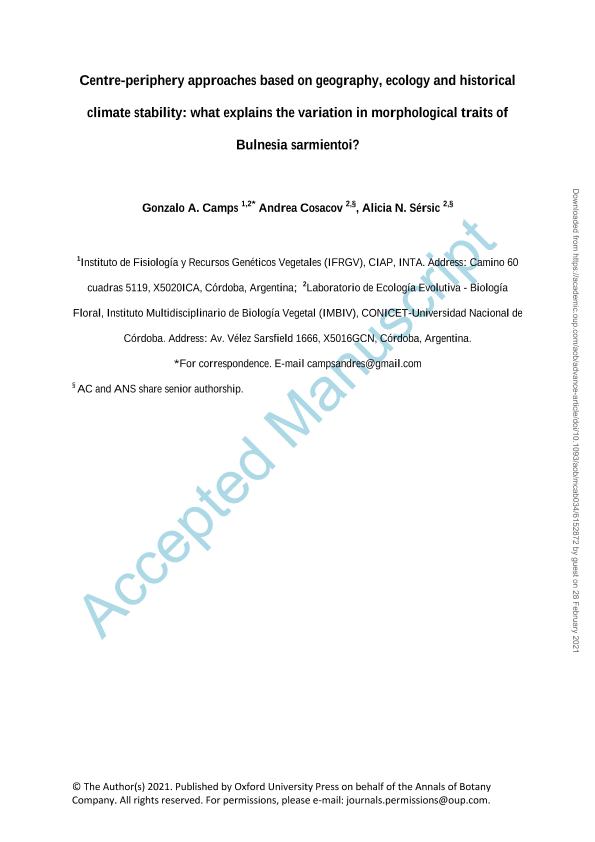Mostrar el registro sencillo del ítem
dc.contributor.author
Camps, Gonzalo Andres

dc.contributor.author
Cosacov Martinez, Andrea

dc.contributor.author
Sersic, Alicia Noemi

dc.date.available
2021-07-13T11:30:49Z
dc.date.issued
2021-06
dc.identifier.citation
Camps, Gonzalo Andres; Cosacov Martinez, Andrea; Sersic, Alicia Noemi; Centre–periphery approaches based on geography, ecology and historical climate stability: What explains the variation in morphological traits of Bulnesia sarmientoi ?; Oxford University Press; Annals of Botany; 127; 7; 6-2021; 943-955
dc.identifier.issn
0305-7364
dc.identifier.uri
http://hdl.handle.net/11336/135916
dc.description.abstract
The Centre-Periphery Hypothesis posits that higher species performance is expected in geographic and ecological centres rather than in peripheral populations. However, this is not the commonly found pattern; therefore, alternative approaches, including the historical dimension of species geographical ranges should be explored. Morphological functional traits are fundamental determinants of species performance, commonly related to environmental stability and productivity. We tested whether or not historical processes may have shaped variations in tree and leaf traits of the Chaco tree Bulnesia sarmientoi.MethodsMorphological variation patterns were analysed from three centre-periphery approaches: geographical, ecological and historical. Tree (stem and canopy) and leaf (leaf size and specific leaf area) traits were measured in 24 populations across the species range. A Principal Component Analysis was performed on morphological traits to obtain synthetic variables. Linear Mixed-Effects Models were used to test which of the implemented centre-periphery approaches significantly explained trait spatial patterns.Key ResultsThe patterns retrieved from the three centre-periphery approaches were not concordant. The historical approach revealed that trees were shorter in center populations than in the periphery. Significant differences in leaf traits were observed between the geographical centre and the periphery, mainly due to low specific leaf area values towards the geographical centre. We did not find any pattern associated with the ecological centre-periphery approach.ConclusionsThe decoupled response between leaf and tree traits suggests that these sets of traits respond differently to processes occurring at different times. The geographical and historical approaches showed centres with extreme environments in relation to their respective peripheries, but the historical centre has also been a climatically stable area since the Last Glacial Maximum. The historical approach allowed for the recovery of historical processes underlying tree traits variation, highlighting that centre-periphery delimitations should be based on a multi-approach framework.
dc.format
application/pdf
dc.language.iso
eng
dc.publisher
Oxford University Press

dc.rights
info:eu-repo/semantics/openAccess
dc.rights.uri
https://creativecommons.org/licenses/by-nc-sa/2.5/ar/
dc.subject
CENTRE-PERIPHERY HYPOTHESIS
dc.subject
GRAN CHACO
dc.subject
ECOLOGICAL NICHE MODELLING
dc.subject
GEOGRAPHICAL CENTRE
dc.subject
INTRASPECIFIC TRAITS
dc.subject
BULNESIA SARMIENTOI
dc.subject
MARGINAL PLANT POPULATIONS
dc.subject
NICHE CENTROID
dc.subject
REFUGIUM
dc.subject.classification
Ciencias de las Plantas, Botánica

dc.subject.classification
Ciencias Biológicas

dc.subject.classification
CIENCIAS NATURALES Y EXACTAS

dc.title
Centre–periphery approaches based on geography, ecology and historical climate stability: What explains the variation in morphological traits of Bulnesia sarmientoi ?
dc.type
info:eu-repo/semantics/article
dc.type
info:ar-repo/semantics/artículo
dc.type
info:eu-repo/semantics/publishedVersion
dc.date.updated
2021-07-12T13:15:33Z
dc.identifier.eissn
1095-8290
dc.journal.volume
127
dc.journal.number
7
dc.journal.pagination
943-955
dc.journal.pais
Reino Unido

dc.journal.ciudad
Oxford
dc.description.fil
Fil: Camps, Gonzalo Andres. Instituto Nacional de Tecnología Agropecuaria. Centro de Investigaciones Agropecuarias. Instituto de Fisiología y Recursos Genéticos Vegetales; Argentina. Consejo Nacional de Investigaciones Científicas y Técnicas; Argentina
dc.description.fil
Fil: Cosacov Martinez, Andrea. Consejo Nacional de Investigaciones Científicas y Técnicas. Centro Científico Tecnológico Conicet - Córdoba. Instituto Multidisciplinario de Biología Vegetal. Universidad Nacional de Córdoba. Facultad de Ciencias Exactas Físicas y Naturales. Instituto Multidisciplinario de Biología Vegetal; Argentina
dc.description.fil
Fil: Sersic, Alicia Noemi. Consejo Nacional de Investigaciones Científicas y Técnicas. Centro Científico Tecnológico Conicet - Córdoba. Instituto Multidisciplinario de Biología Vegetal. Universidad Nacional de Córdoba. Facultad de Ciencias Exactas Físicas y Naturales. Instituto Multidisciplinario de Biología Vegetal; Argentina
dc.journal.title
Annals of Botany

dc.relation.alternativeid
info:eu-repo/semantics/altIdentifier/url/https://academic.oup.com/aob/advance-article/doi/10.1093/aob/mcab034/6152872
dc.relation.alternativeid
info:eu-repo/semantics/altIdentifier/doi/https://doi.org/10.1093/aob/mcab034
Archivos asociados
